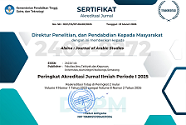Kesalahan Penerjemahan Google Translate Pada Hadis Arbain Berdasarkan Konteks Keagamaan (Kajian Akar Kata dan Morfologi Turunan)
DOI:
https://doi.org/10.21580/alsina.4.1.8332Keywords:
Google Translate, hadith arbain, morphology, root words, translationAbstract
Translation is the activity producing a source language message with the closest and natural equivalent to the recipient's language, both in terms of meaning and style. The translation process requires grammatical and lexical adjustments to evade unusual structures in the recipient's language. Translation activities are not only done by humans. With the advancement of technology, electronic translation tools have emerged such as Google Translate to translate parts of text or web pages from one language to another. This study aims to describe the Google Translate system in translating a Hadith Arbain text and to analyze the forms of translation errors in the study of root words and derived morphology. This research is a qualitative descriptive study with the source of data and the object is the translation of the Google translation and the Hadith Arbain. Data collection is done by documentation. Error analysis is used in conducting data analysis of translation errors to find errors in the meaning of Arabic morphology forms against Indonesian and vice versa, grammatical errors, meaning of the same root words but different sounds, meaning of glorification, classifying words of the original language into the target language, the use of inappropriate target words, translation, and the meaning of Islamic concepts.
Downloads
References
Aitchison, Jean. Linguistics. London: Hodder Headline, 2008.
Al-Ayubi, Muhammad Shalehuddin. “Pemanfaatan Google Translator sebagai Media Pembelajaran pada Terjemahan Teks Berita Asing.” Jurnal Teknodik 21, no. 2 (2017): 155–66. https://doi.org/10.32550/teknodik.v21i2.225.
Al-Fādānī, Muḥammad Yāsīn. Al-Arbaʿūn al-Buldānīyah: Arbaʿūn Ḥadīthan ʿan Arbaʿīn Shaykhan min Arbaʿīn Baladan. Beirut: Dār al-Bashā’ir al-Islāmīyah, 1986.
Al-Hanbali, Ibn Rajab. The Compendium of Knowledge and Wisdom. Translated by Abdassamd Clarke. London: Turath Publishing, 2007.
Al-Utsaimin, Muhammad bin Shalih. Syarah Arba’in An-Nawawi : Penjelasan Hadis-hadis tentang Pokok-pokok Ajaran Agama Islam. Translated by Fathoni Muhammad and Muhammad Muhtadi. Jakarta: Darus Sunnah, 2019.
Alfarisi. Pedoman Penerjemahan Arab Indonesia. Bandung: Remaja Rosdakarya, 2011.
Amilia, Ika Kartika, and Darmawan Eko Yuwono. “A Study of The Translation of Google Translate.” LINGUA : JURNAL ILMIAH 16, no. 2 (2020): 1–21. https://doi.org/10.35962/lingua.v16i2.50.
Anggaira, Aria Septi. “Linguistic Errors on Narrative Text Translation Using Google Translate.” Pedagogy : Journal of English Language Teaching 5, no. 1 (2017): 1–14. https://doi.org/10.32332/pedagogy.v5i1.717.
Arifatun, Novia. “Kesalahan Penerjemahan Teks Bahasa Indonesia ke Bahasa Arab Melalui Google Translate (Studi Analisis Sintaksis).” Lisanul Arab: Journal of Arabic Learning and Teaching 1, no. 1 (2012): 1–6. https://journal.unnes.ac.id/sju/index.php/laa/article/view/1506.
Baihaqi, Akhmad, and Away Mulyana. “Reviewing The Result of Machine Translation: A Case For Indonesian Translation Version By Google Translate and Imtranslator.” PROJECT (Professional Journal of English Education) 4, no. 1 (2021): 1–9. https://doi.org/10.22460/project.v4i1.p1-9.
Chaer, Abdul. Morfologi Bahasa Indonesia Pendekatan Proses. Jakarta: Rineka Cipta, 2008.
Choliludin. The Technique of Making Idiomatic Translation. Jakarta: Kesaint Blanc, 2005.
Departemen Pendidikan Indonesia. Kamus Besar Bahasa Indonesia. Jakarta: Balai Pustaka, 2008.
Faqih, Ahmad. “Penggunaan Google Translate dalam Penerjemahan Teks Bahasa Arab ke dalam Bahasa Indonesia.” ALSUNIYAT: Jurnal Penelitian Bahasa, Sastra, dan Budaya Arab 1, no. 2 (2018): 88–97. https://doi.org/10.17509/alsuniyat.v1i2.24216.
Fauziyah, Asmaul. Akurasi Hasil Terjemahan Bahasa Arab ke dalam Bahasa Indonesia dengan Aplikasi Google Translate (Undergraduate Thesis). Malang: Universitas Negeri Malang, 2012. http://repository.um.ac.id/id/eprint/11230.
Garcia, Ignacio, and María Isabel Pena. “Machine Translation-Assisted Language Learning: Writing for Beginners.” Computer Assisted Language Learning 24, no. 5 (2011): 471–87. https://doi.org/10.1080/09588221.2011.582687.
Ghalāyīnī, Muṣṭafá. Jāmiʻ al-durūs al-ʻArabīyah. Beirut: Dār al-Kutub al-ʿIlmīyah, 2005.
Ghusthaf, Nail. Kesalahan Penerjemahan Google Translate dalam Menerjemahkan Berita pada Website Cairo University dari Bahasa Arab ke Bahasa Indonesia (Undergraduate Thesis). Surakarta: Universitas Sebelas Maret, 2018.
Hanifah, Umi. Metode Terjemahan: Teori Penerjemahan Arab-Indonesia. Sidoarjo: Dwiputra Pustaka Jaya, 2013.
Hardiyanto. “Indonesia Bahasa Dunia.” Sekretariat Kabinet RI, 2018. https://setkab.go.id/indonesia-bahasa-dunia/.
Ibn al-ʻAṭṭār, ʻAlī ibn Ibrāhīm. Sharḥ al-Arbaʻīn al-Nawawīyah: al-Maʻrūf bi-Mukhtaṣar al-Nawawī. Beirut: Dār al-Bashāʼir al-Islāmīyah, 2008.
Kane, Vichard L. “Interpretation and Machine Translation towards Google Translate as a Part of Machine Translation and Teaching Translation.” Applied Translation 15, no. 1 (2021): 10–17. https://doi.org/10.51708/apptrans.v15n1.1337.
Khoiriyah, Hidayatul. “Metode Qirā’ah Dalam Pembelajaran Keterampilan Reseptif Berbahasa Arab Untuk Pendidikan Tingkat Menengah.” LISANUNA: Jurnal Ilmu Bahasa Arab Dan Pembelajarannya 10, no. 1 (2020): 32–44. https://doi.org/10.22373/ls.v10i1.7804.
Koehn, Philipp. Statistical Machine Translation. Cambridge: Cambridge University Press, 2009. https://doi.org/10.1017/CBO9780511815829.
Kridalaksana, Harimurti. Kamus Linguistik. Jakarta: Gramedia, 2011.
———. Pembentukan Kata dalam Bahasa Indonesia. Jakarta: PT Gramedia Pustaka Utama, 2009.
Lawa, Selfiana T.M. Ndapa, Christmas P. Ate, and Viktorius P. Feka. “Penggunaan Google Translate sebagai Alternatif Media Penerjemah pada Abstrak Jurnal Mahasiswa.” HINEF : Jurnal Rumpun Ilmu Pendidikan 1, no. 1 (2022): 86–93. https://ojs.cbn.ac.id/index.php/hinef/article/view/431.
Mansur, M. Panduan terjemah Pedoman Bagi Penerjemahan Arab-Indonesia-Arab. Jakarta: PT. Moyo Segoro Agung, 2002.
Munday, Jeremy. Introducing Translation Studies: Theories and Aplications. London: Routledge, 2008.
Nababan, Mangatur, Ardiani Nuraeni, and Sumardiono. “Pengembangan Model Penilaian Kualitas Terjemahan.” Kajian Linguistik dan Sastra 24, no. 1 (2012): 39–57. https://doi.org/10.23917/kls.v24i1.101.
Pringgawidagda, Suwarna. Strategi Penguasaan Berbahasa. Yogyakarta: Adicita Karya Nusa, 2002.
Rahman, Mustafa Abdul. Hadith 40: Terjemahan dan Syarahnya. Selangor: Dewan Pustaka Fajar, 1992.
Randa, Reki. “Analisis Kesalahan Kebahasaan Hasil Terjemahan Google Translate Pada Syair Ilaika.” Jurnal Pendidikan Bahasa Arab dan Budaya Islam 3, no. 1 (2022): 1–11. https://online-journal.unja.ac.id/Ad-Dhuha/article/view/18019.
Sa’diyah, Zaimatus. “Tipologi Kesalahan Kebahasaan dan Keakuratan Hasil Terjemahan Google Translate Teks Bahasa Indonesia ke Dalam Bahasa Arab.” Arabia: Jurnal Pendidikan Bahasa Arab 6, no. 2 (2014): 273–93. https://doi.org/10.21043/ARABIA.V6I2.1404.
Shaukat, Jamila. Classification of Hadith Literature. London: Autumn, 1985.
Umam, Mustolikh Khabibul. “Google Translate in Tarjamah Learning at Arabic Language Education UIN Walisongo Semarang.” Mantiqu Tayr: Journal of Arabic Language 1, no. 1 (2021): 59–68. https://doi.org/10.25217/mantiqutayr.v1i1.1279.
Utama, Muhammad Apridho Hensa, and Moh. Masrukhi. “Analisis Teknik Penerjemahan Bahasa Arab ke Bahasa Indonesia dalam Ceramah Habib Umar Bin Hafidz.” Al-Tsaqafa : Jurnal Ilmiah Peradaban Islam 18, no. 2 (2021): 191–200. https://doi.org/10.15575/al-tsaqafa.v18i2.13184.
Downloads
Published
How to Cite
Issue
Section
License
Copyright
The copyright of the received article shall be assigned to the publisher of the journal. The intended copyright includes the right to publish the article in various forms (including reprints). The journal maintains the publishing rights to published articles. Authors are allowed to use their articles for any legal purposes deemed necessary without written permission from the journal, but with an acknowledgment to this journal of initial publication.
Licensing
In order for Alsina: Journal of Arabic Studies to publish and distribute research articles, the editors need publishing rights (transferred from author to publisher). This agreement relates to the transfer/publishing copyright license to Alsina: Journal of Arabic Studies but the authors still have significant rights to use and share their published articles.
Alsina: Journal of Arabic Studies supports the need for writers to share, disseminate and maximize the impact of their research and their rights on any database. As a journal article writer, you have the right to various uses of your articles, including that by the institution or company where you work. Copyright can be used without the need for special permission. Authors who publish articles in the Alsina: Journal of Arabic Studies have broad rights to use their work for teaching and scientific purposes without requesting permission, including:
- Use by the author for lectures, presentations, or conferences, with distribution of copies to participants;
- Distribution to colleagues for research use;
- Use in compilations of the author's subsequent work;
- inclusion in a thesis or dissertation;
- Reuse of sections or excerpts from articles in other works (with full acknowledgment of the final article);
- Preparation of derivative works (other than commercial purposes) (with full acknowledgment of the final article);
- Voluntary posting on open websites operated by authors’ or writers' agencies for scientific purposes
When submitting a manuscript, authors do so on the understanding that if accepted for publication, the copyright for publishing (publishing right) of the article shall be assigned/transferred to Alsina: Journal of Arabic Studies.
Authors whose articles are accepted for publication will receive confirmation via email and sent a Copyright Transfer Agreement.


 Accreditation
Accreditation 
 In Collaboration with
In Collaboration with 

 Visitors
Visitors  Article Template
Article Template





